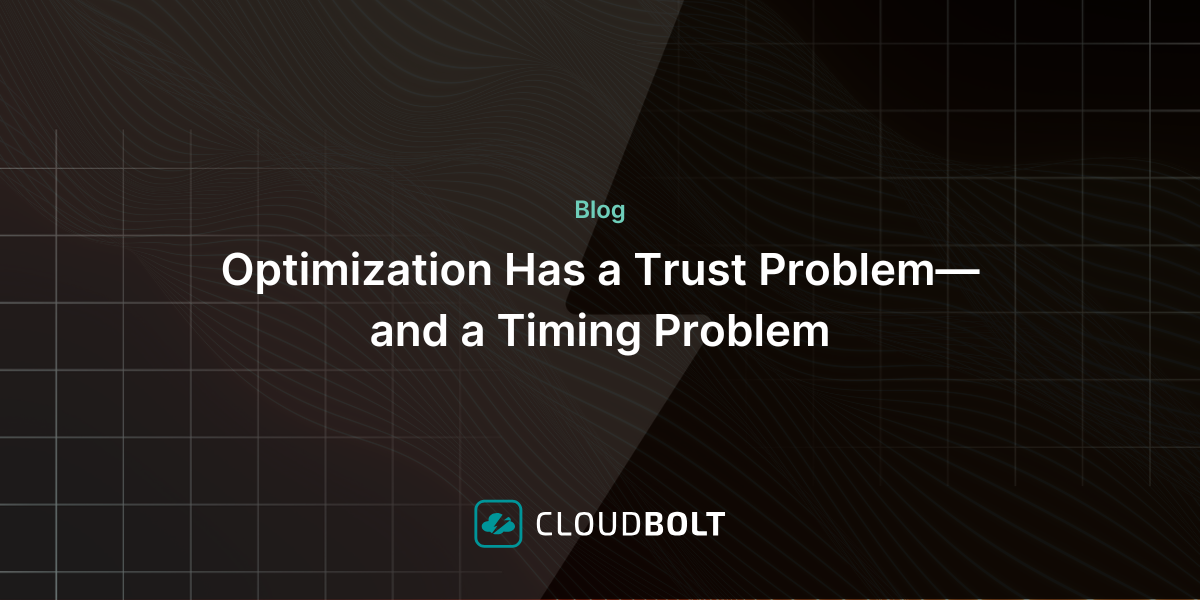The 3 Myths Keeping Your Infrastructure Static
Most organizations treat operational maturity like a wall of green checks. Uptime’s high. Nothing’s on fire. The dashboard’s quiet.
However, in reality, that stillness can be a sign of risk, not resilience.
In his Converge 2025 “Manage” session, CloudBolt Chief Technology & Product Officer Kyle Campos challenged the idea that maturity comes from minimizing change. “Operational maturity isn’t about avoiding change,” he said. “It’s about optimizing a continuous flow of it.”
Yet, most teams are still operating under outdated assumptions—ones that keep infrastructure static, fragile, and hard to evolve.
Here are the four myths holding teams back and what it takes to move forward.
Myth 1: High uptime is a sign of stability
“We’ve all been proud of that one server that’s been up for 427 days,” Kyle joked. “But the longer something lives untouched, the more likely it is to fail the moment you try to change it.”
Long-lived instances accumulate silent risk:
- Deployment automation atrophies
- Patches and CVEs pile up
- Configurations drift from source of truth
- Manual changes (via SSH or tribal knowledge) never get ported back
Even if your team thinks it can redeploy that infrastructure, confidence and reality often diverge. “I asked a room of ops people, ‘Could you redeploy your entire stack today?’ Half said yes. Then I asked, ‘Have you actually done it?’ Fewer hands stayed up.”
This is the atrophy effect: if you don’t exercise deployment, it decays. “Redeploy regularly, even if there’s no new code,” Kyle recommended. “Not for speed. For control.”
Myth 2: TTL is just for lab environments
Time-to-live policies are often associated with dev sandboxes and cleanup scripts. But Kyle argues they’re essential in production too because time itself should trigger change.
“There are events that trigger change—and then there’s time,” he said. “And time-based triggers are just as important for system health.”
Examples he cited include:
- Daily patch pipelines that auto-promote to image stores
- Weekly repaving of infrastructure from golden images (even without config changes)
- Scheduled credential rotation based on sensitivity level
- Periodic performance or chaos testing to validate assumptions
“Time is your enemy when infra is static,” Kyle said. “The longer it lives, the more it diverges from what you think it is.”
TTLs aren’t about deleting things for fun. They’re about operational hygiene. And when paired with codified automation, they ensure your systems can change on purpose without disruption.
Myth 3: Interdependencies block automation
Dependencies between teams, systems, and clouds are often seen as blockers. In reality, they’re just unacknowledged requirements.
“Everyone thinks, ‘I don’t have time to integrate with that other team,’” said Cofounder and VP of Customer Support & Product Architect Auggy da Rocha during the session. “But the truth is, those handoffs and constraints aren’t excuses. They’re the shape of the automation you need.”
Kyle framed it this way: “If it’s something you worry about, put it in a test. If it’s a concern, codify it. Get the anxiety out of your head and into the blueprint.”
When cross-team concerns are codified—whether it’s maintenance windows, fault domains, SLAs, or change windows—automation becomes possible because of those dependencies, not in spite of them.
Bringing It All Together
The message from Kyle’s session was clear: you can’t control what you can’t change.
- Redeploy rate is a better metric than uptime.
- Static infrastructure isn’t stable; it’s decaying.
- Time-triggered automation is maturity, not experimentation.
- And every scary interdependency is just a blueprint waiting to happen.
If operational maturity is the goal, static infra isn’t the cost of stability—it’s the barrier to it.
Standardize, codify, and orchestrate change without fear.
Schedule a custom demo

Related Blogs

Bill-Accurate Kubernetes Cost Allocation, Now Built Into CloudBolt
CloudBolt is introducing granular Kubernetes cost allocation directly within the platform. This new capability delivers bill-level accuracy down to the…

